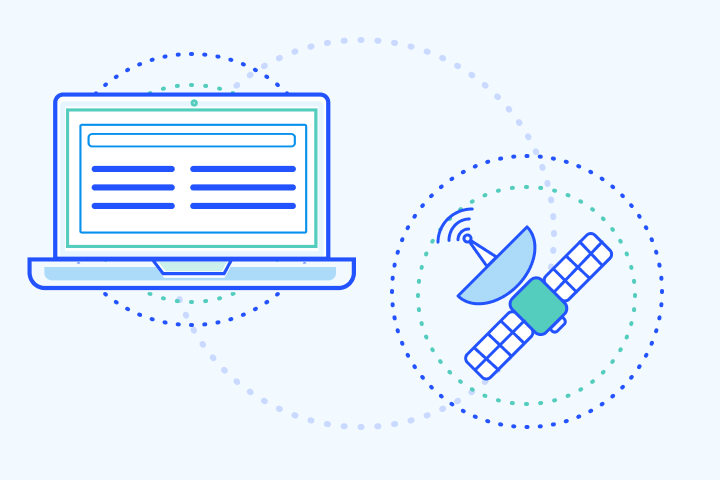Satellite Internet Download & Upload Speed

HighSpeedOptions prides itself on providing honest, quality content. While we may be compensated when you make a purchase through links on our site, all opinions are our own. Here's how we make money.
Table of Contents
If you’re searching for satellite internet for your home, there are many options to consider when choosing a plan. One of the most significant considerations people have when shopping for internet providers is determining their internet speed needs. After all, speed determines what is or isn’t possible with your internet connection.
But the speed advertised in an internet plan is the download speed, and it’s one side of the equation. That’s because most of what we do involves getting data–whether it be video streaming or checking email–from the internet downstream to our device.
The speed that is often not highlighted in internet plans is the upload speed. Understanding download speed and upload speed are crucial to picking the right satellite internet provider and plan. Do you upload photos and videos to social media, or work from home? Then upload speed should be something to compare.
HughesNet internet and Viasat internet each have multiple plans to choose from with varying download and upload speeds at different price points. This guide helps you understand the difference between download and upload speed and what to consider when looking for satellite internet service.
- Fast satellite internet
- Ideal for rural areas
- Up to 3x faster than DSL*
Satellite Internet Download Speed
As mentioned, download speed is a measure of how fast data travels from the internet to your device. This is the speed internet providers use when describing their plans since it is most important to how people use the internet–loading webpages, images, listening to music, downloading files, streaming video, etc.
The more data-intense the activity is (streaming HD or 4K video, downloading movies to your device, or transferring large files to your laptop), the more it will benefit from faster speeds. Streaming video in particular performs better with faster speeds as it reduces buffering time.
Typical satellite internet download speeds are between 25-150 Mbps; however, Starlink satellite internet is capable of speeds up to 200 Mbps, depending on location.
Satellite Internet Upload Speed
Since all internet connections are two-way streets, it’s important to consider upload speed, or how fast data can be transferred upstream to the internet from your device. Sending emails, uploading media to YouTube or Instagram, and videoconferencing are all activities that utilize upload speed. Also, people concerned with online gaming speeds rely on upload speed to maintain a competitive advantage.
Upload speeds are typically less important for general browsing, reading news articles, etc. However, if you engage in activities that demand more upstream data transfer, you’ll want to make upload speed a key factor to consider.
Upload speeds for most satellite internet service provides are relatively slow, ranging from 5-10 Mbps.
Symmetrical Speeds
Some internet connections are capable of symmetrical speeds, where the download and upload speeds are the same. This is mostly offered by fiber internet providers, and typically not found in satellite internet plans.
Satellite Speeds Compared to Other Types of Internet
Satellite internet speeds are typically slower than other types such as fiber, cable, and DSL internet. The average download speed for satellite internet is about 100 Mbps. Fiber internet, on the other hand, can offer gigabit speeds (+1000 Mbps), providing significantly faster downloads and uploads. Cable and DSL speeds vary but usually offer higher download speeds than satellite, typically in the range of 100 to 500 Mbps. However, satellite internet has much wider availability than any of these types of internet connections.
Other Speed Considerations
Before getting started on your search, it’s good to have an understanding of what you’re purchasing and the capabilities of your satellite internet connection. It’s also important to note here that severe weather can have an affect on the performance of your satellite internet.
Bandwidth
Speed and bandwidth are commonly used interchangeably, and while they use the same quantity, they measure different things. Think of an internet connection as a road. Speed measures how fast a car (data) can get from point A to point B on that road. Bandwidth measures how many cars (data size) can travel on the road at the same time.
A 25 Mbps plan can move up to 25 megabytes of data at a given moment. In other words, a 100-megabyte file can be transferred from point A to point B in 4 seconds. Therefore, internet plans with higher speeds can move data faster and move more of it at one time. Homes with multiple users and devices benefit greatly from faster (more bandwidth) connections.
Latency
Speed and bandwidth are important, but how fast can data make a round trip over your connection? Ping tests are used to measure how fast a small data packet can be sent from your computer to a server on the internet (usually the satellite internet provider network hub) and back to your computer.
The result is called a ping rate and is measured in milliseconds. It is a measure of internet latency (lag), and the lower the number the better. A high latency indicates that there may be network congestion or some sort of interference along the connection. Low latency is important for online gaming and can determine whether you win or lose the match in a matter of milliseconds.
Latency is not something that is usually reported in the specs of an internet connection. Ping rate is unique to your location, equipment, connection type, and many other contributing factors. And you can’t test it until your internet service is set up.
Next Steps
Keep in mind that the speed advertised in any given satellite internet plan indicates its top speed. Many things can affect your overall speed, and it can change in different parts of your house, and it’s common for your actual speed to be lower than the advertised speed.
We advise you to run an internet speed test on your current connection to get a measure of download speed, upload speed, and latency. If your current speeds are considerably slower than what you’re paying for, we recommend contacting your provider. If you’re on the hunt for a new provider, enter your zip below to find other satellite internet providers in your area.
Find providers in your area
Table of Contents







